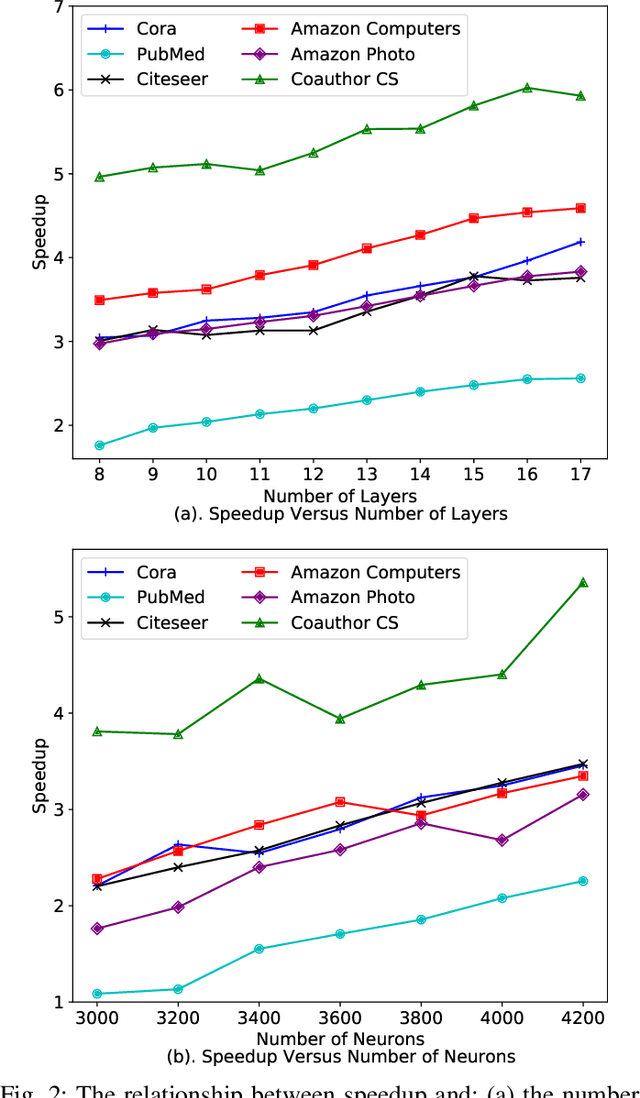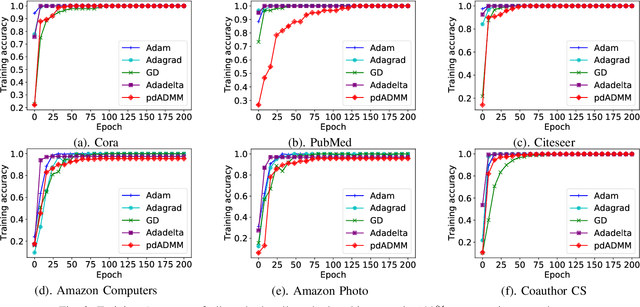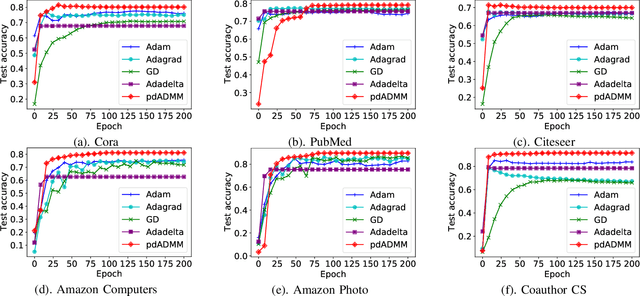Hongyi Li
LHT: Statistically-Driven Oblique Decision Trees for Interpretable Classification
May 07, 2025Abstract:We introduce the Learning Hyperplane Tree (LHT), a novel oblique decision tree model designed for expressive and interpretable classification. LHT fundamentally distinguishes itself through a non-iterative, statistically-driven approach to constructing splitting hyperplanes. Unlike methods that rely on iterative optimization or heuristics, LHT directly computes the hyperplane parameters, which are derived from feature weights based on the differences in feature expectations between classes within each node. This deterministic mechanism enables a direct and well-defined hyperplane construction process. Predictions leverage a unique piecewise linear membership function within leaf nodes, obtained via local least-squares fitting. We formally analyze the convergence of the LHT splitting process, ensuring that each split yields meaningful, non-empty partitions. Furthermore, we establish that the time complexity for building an LHT up to depth $d$ is $O(mnd)$, demonstrating the practical feasibility of constructing trees with powerful oblique splits using this methodology. The explicit feature weighting at each split provides inherent interpretability. Experimental results on benchmark datasets demonstrate LHT's competitive accuracy, positioning it as a practical, theoretically grounded, and interpretable alternative in the landscape of tree-based models. The implementation of the proposed method is available at https://github.com/Hongyi-Li-sz/LHT_model.
SATA: Safe and Adaptive Torque-Based Locomotion Policies Inspired by Animal Learning
Feb 18, 2025Abstract:Despite recent advances in learning-based controllers for legged robots, deployments in human-centric environments remain limited by safety concerns. Most of these approaches use position-based control, where policies output target joint angles that must be processed by a low-level controller (e.g., PD or impedance controllers) to compute joint torques. Although impressive results have been achieved in controlled real-world scenarios, these methods often struggle with compliance and adaptability when encountering environments or disturbances unseen during training, potentially resulting in extreme or unsafe behaviors. Inspired by how animals achieve smooth and adaptive movements by controlling muscle extension and contraction, torque-based policies offer a promising alternative by enabling precise and direct control of the actuators in torque space. In principle, this approach facilitates more effective interactions with the environment, resulting in safer and more adaptable behaviors. However, challenges such as a highly nonlinear state space and inefficient exploration during training have hindered their broader adoption. To address these limitations, we propose SATA, a bio-inspired framework that mimics key biomechanical principles and adaptive learning mechanisms observed in animal locomotion. Our approach effectively addresses the inherent challenges of learning torque-based policies by significantly improving early-stage exploration, leading to high-performance final policies. Remarkably, our method achieves zero-shot sim-to-real transfer. Our experimental results indicate that SATA demonstrates remarkable compliance and safety, even in challenging environments such as soft/slippery terrain or narrow passages, and under significant external disturbances, highlighting its potential for practical deployments in human-centric and safety-critical scenarios.
Learning Hyperplane Tree: A Piecewise Linear and Fully Interpretable Decision-making Framework
Jan 15, 2025



Abstract:This paper introduces a novel tree-based model, Learning Hyperplane Tree (LHT), which outperforms state-of-the-art (SOTA) tree models for classification tasks on several public datasets. The structure of LHT is simple and efficient: it partitions the data using several hyperplanes to progressively distinguish between target and non-target class samples. Although the separation is not perfect at each stage, LHT effectively improves the distinction through successive partitions. During testing, a sample is classified by evaluating the hyperplanes defined in the branching blocks and traversing down the tree until it reaches the corresponding leaf block. The class of the test sample is then determined using the piecewise linear membership function defined in the leaf blocks, which is derived through least-squares fitting and fuzzy logic. LHT is highly transparent and interpretable--at each branching block, the contribution of each feature to the classification can be clearly observed.
JailPO: A Novel Black-box Jailbreak Framework via Preference Optimization against Aligned LLMs
Dec 20, 2024Abstract:Large Language Models (LLMs) aligned with human feedback have recently garnered significant attention. However, it remains vulnerable to jailbreak attacks, where adversaries manipulate prompts to induce harmful outputs. Exploring jailbreak attacks enables us to investigate the vulnerabilities of LLMs and further guides us in enhancing their security. Unfortunately, existing techniques mainly rely on handcrafted templates or generated-based optimization, posing challenges in scalability, efficiency and universality. To address these issues, we present JailPO, a novel black-box jailbreak framework to examine LLM alignment. For scalability and universality, JailPO meticulously trains attack models to automatically generate covert jailbreak prompts. Furthermore, we introduce a preference optimization-based attack method to enhance the jailbreak effectiveness, thereby improving efficiency. To analyze model vulnerabilities, we provide three flexible jailbreak patterns. Extensive experiments demonstrate that JailPO not only automates the attack process while maintaining effectiveness but also exhibits superior performance in efficiency, universality, and robustness against defenses compared to baselines. Additionally, our analysis of the three JailPO patterns reveals that attacks based on complex templates exhibit higher attack strength, whereas covert question transformations elicit riskier responses and are more likely to bypass defense mechanisms.
General-purpose Dataflow Model with Neuromorphic Primitives
Aug 02, 2024



Abstract:Neuromorphic computing exhibits great potential to provide high-performance benefits in various applications beyond neural networks. However, a general-purpose program execution model that aligns with the features of neuromorphic computing is required to bridge the gap between program versatility and neuromorphic hardware efficiency. The dataflow model offers a potential solution, but it faces high graph complexity and incompatibility with neuromorphic hardware when dealing with control flow programs, which decreases the programmability and performance. Here, we present a dataflow model tailored for neuromorphic hardware, called neuromorphic dataflow, which provides a compact, concise, and neuromorphic-compatible program representation for control logic. The neuromorphic dataflow introduces "when" and "where" primitives, which restructure the view of control. The neuromorphic dataflow embeds these primitives in the dataflow schema with the plasticity inherited from the spiking algorithms. Our method enables the deployment of general-purpose programs on neuromorphic hardware with both programmability and plasticity, while fully utilizing the hardware's potential.
i-Octree: A Fast, Lightweight, and Dynamic Octree for Proximity Search
Sep 15, 2023



Abstract:Establishing the correspondences between newly acquired points and historically accumulated data (i.e., map) through nearest neighbors search is crucial in numerous robotic applications.However, static tree data structures are inadequate to handle large and dynamically growing maps in real-time.To address this issue, we present the i-Octree, a dynamic octree data structure that supports both fast nearest neighbor search and real-time dynamic updates, such as point insertion, deletion, and on-tree down-sampling. The i-Octree is built upon a leaf-based octree and has two key features: a local spatially continuous storing strategy that allows for fast access to points while minimizing memory usage, and local on-tree updates that significantly reduce computation time compared to existing static or dynamic tree structures.The experiments show that i-Octree surpasses state-of-the-art methods by reducing run-time by over 50% on real-world open datasets.
A Convergent ADMM Framework for Efficient Neural Network Training
Dec 22, 2021



Abstract:As a well-known optimization framework, the Alternating Direction Method of Multipliers (ADMM) has achieved tremendous success in many classification and regression applications. Recently, it has attracted the attention of deep learning researchers and is considered to be a potential substitute to Gradient Descent (GD). However, as an emerging domain, several challenges remain unsolved, including 1) The lack of global convergence guarantees, 2) Slow convergence towards solutions, and 3) Cubic time complexity with regard to feature dimensions. In this paper, we propose a novel optimization framework to solve a general neural network training problem via ADMM (dlADMM) to address these challenges simultaneously. Specifically, the parameters in each layer are updated backward and then forward so that parameter information in each layer is exchanged efficiently. When the dlADMM is applied to specific architectures, the time complexity of subproblems is reduced from cubic to quadratic via a dedicated algorithm design utilizing quadratic approximations and backtracking techniques. Last but not least, we provide the first proof of convergence to a critical point sublinearly for an ADMM-type method (dlADMM) under mild conditions. Experiments on seven benchmark datasets demonstrate the convergence, efficiency, and effectiveness of our proposed dlADMM algorithm.
Community-based Layerwise Distributed Training of Graph Convolutional Networks
Dec 17, 2021



Abstract:The Graph Convolutional Network (GCN) has been successfully applied to many graph-based applications. Training a large-scale GCN model, however, is still challenging: Due to the node dependency and layer dependency of the GCN architecture, a huge amount of computational time and memory is required in the training process. In this paper, we propose a parallel and distributed GCN training algorithm based on the Alternating Direction Method of Multipliers (ADMM) to tackle the two challenges simultaneously. We first split GCN layers into independent blocks to achieve layer parallelism. Furthermore, we reduce node dependency by dividing the graph into several dense communities such that each of them can be trained with an agent in parallel. Finally, we provide solutions for all subproblems in the community-based ADMM algorithm. Preliminary results demonstrate that our proposed community-based ADMM training algorithm can lead to more than triple speedup while achieving the best performance compared with state-of-the-art methods.
Towards Quantized Model Parallelism for Graph-Augmented MLPs Based on Gradient-Free ADMM framework
May 20, 2021



Abstract:The Graph Augmented Multi-layer Perceptron (GA-MLP) model is an attractive alternative to Graph Neural Networks (GNNs). This is because it is resistant to the over-smoothing problem, and deeper GA-MLP models yield better performance. GA-MLP models are traditionally optimized by the Stochastic Gradient Descent (SGD). However, SGD suffers from the layer dependency problem, which prevents the gradients of different layers of GA-MLP models from being calculated in parallel. In this paper, we propose a parallel deep learning Alternating Direction Method of Multipliers (pdADMM) framework to achieve model parallelism: parameters in each layer of GA-MLP models can be updated in parallel. The extended pdADMM-Q algorithm reduces communication cost by utilizing the quantization technique. Theoretical convergence to a critical point of the pdADMM algorithm and the pdADMM-Q algorithm is provided with a sublinear convergence rate $o(1/k)$. Extensive experiments in six benchmark datasets demonstrate that the pdADMM can lead to high speedup, and outperforms all the existing state-of-the-art comparison methods.
 Add to Chrome
Add to Chrome Add to Firefox
Add to Firefox Add to Edge
Add to Edge